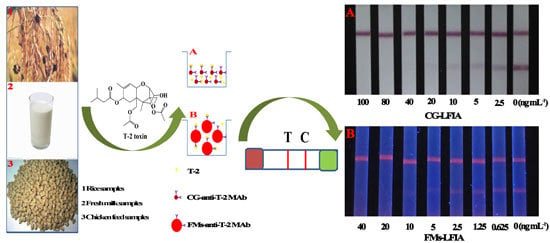Comparison of Fluorescent Microspheres and Colloidal Gold as Labels in Lateral Flow Immunochromatographic Assays for the Detection of T-2 Toxin
Abstract
:1. Introduction
2. Results and Discussion
2.1. MAb Production
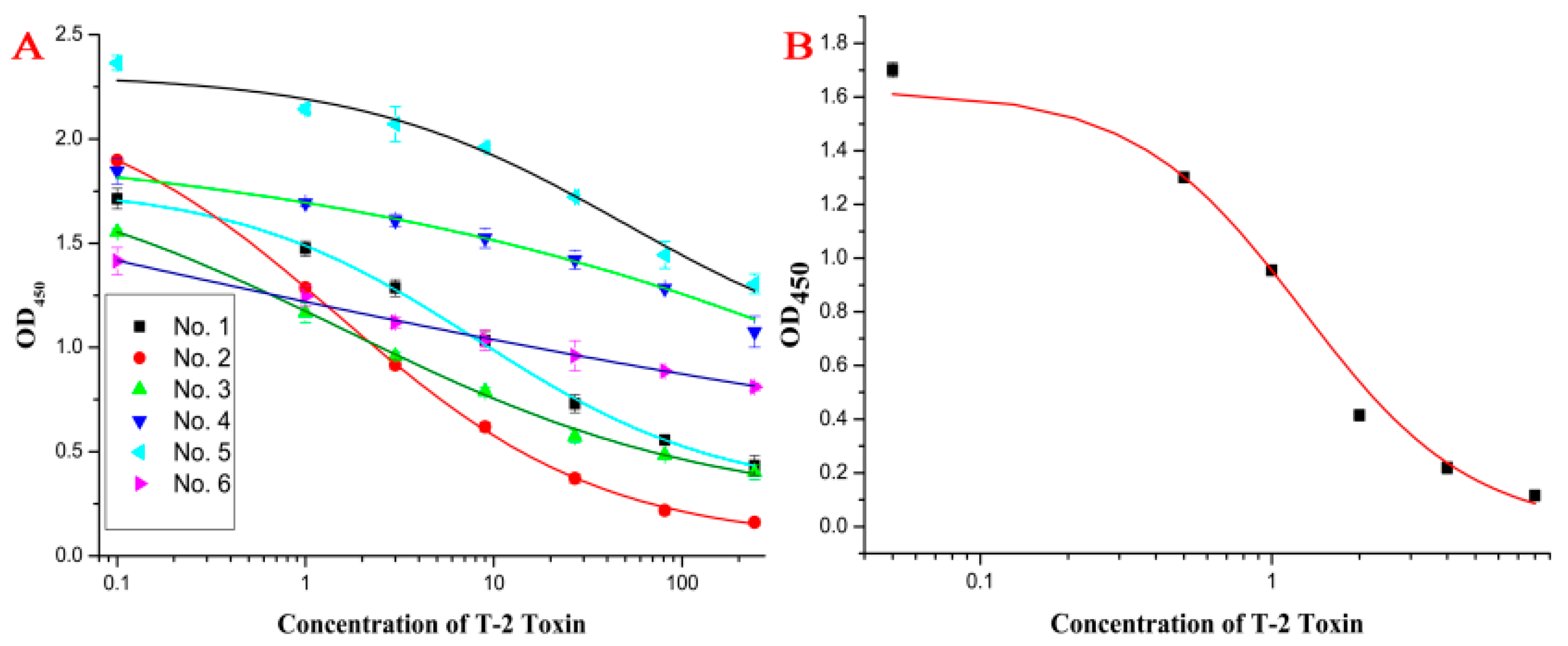
2.2. LFIA Optimization
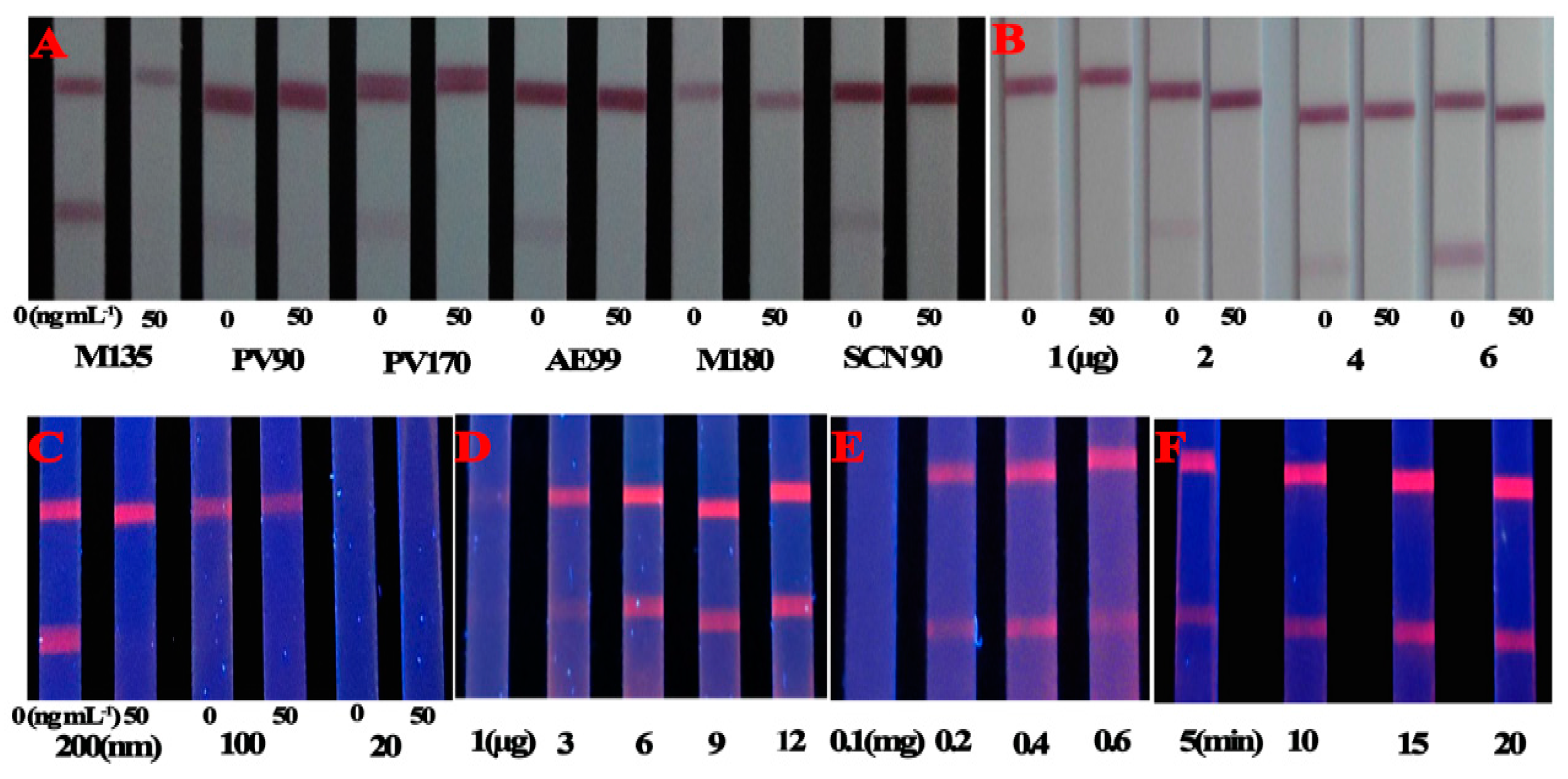
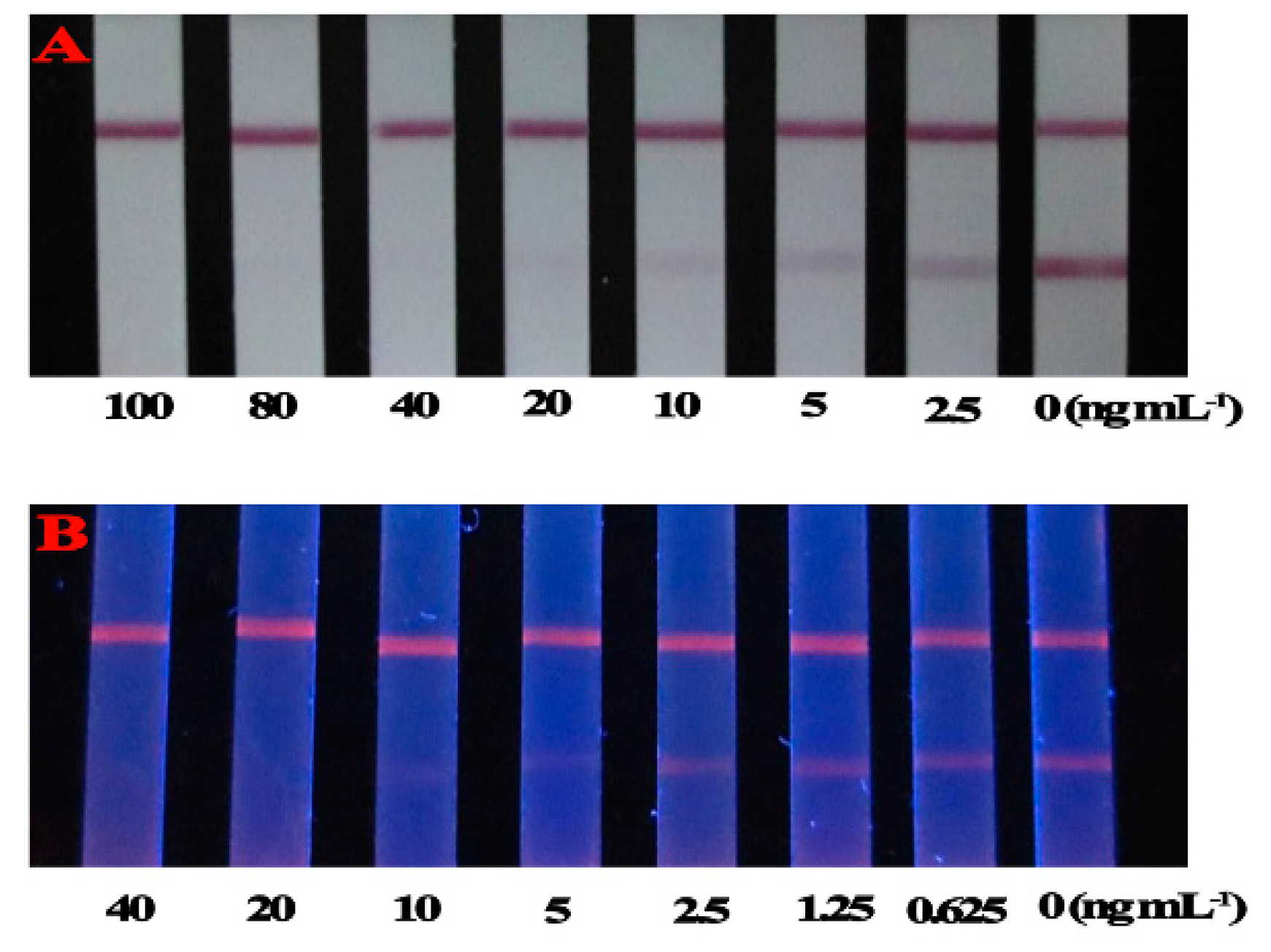
| PBS | Rice | Chicken Feed | |
|---|---|---|---|
| LOD | 0.28 | 0.23 | 0.41 |
| IC50 (ng/mL) | 1.58 | 1.78 | 1.78 |
| IC20~IC80 (ng/mL) | 0.28–8.9 | 0.23–13.7 | 0.41–7.8 |
| R2 | 0.990 | 0.987 | 0.989 |
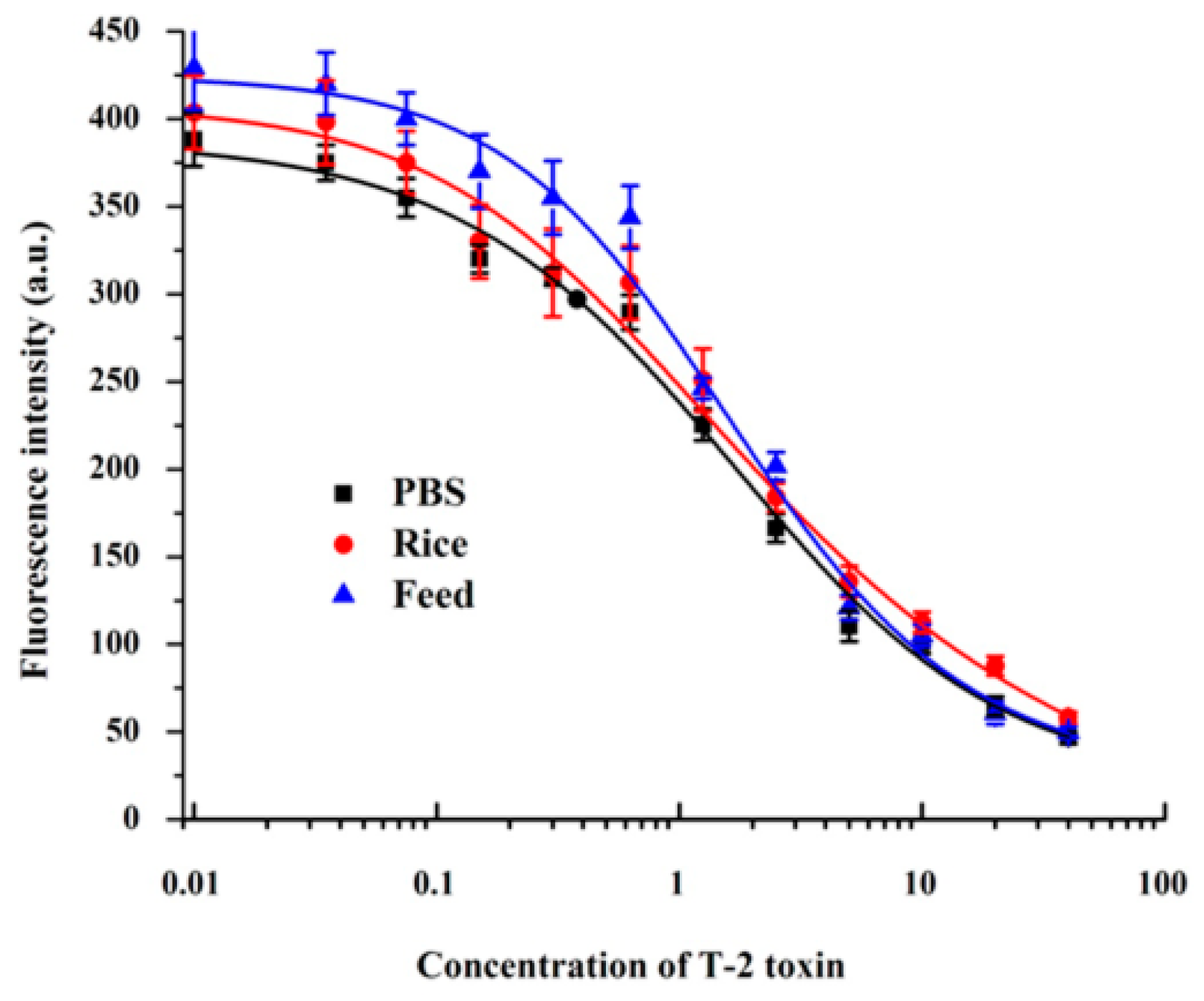
2.3. Comparison between CG-LFIA and FMs-LFIA for Matrix Effect

| Sample | Spiked (μg/kg) | Test (μg/kg) | Recoveries (%) | CV (%) |
|---|---|---|---|---|
| Rice | 5 | 4.748 | 94.9 | 5.42 |
| 10 | 10.08 | 100.8 | 7.51 | |
| 20 | 19.22 | 96.1 | 9.78 | |
| Chicken Feed | 5 | 4.02 | 80.2 | 10.8 |
| 10 | 8.901 | 89 | 9.87 | |
| 20 | 17.56 | 87.8 | 7.56 |
3. Experimental Section
3.1. General Information
3.2. Preparation of Anti-T-2 MAb
3.3. Indirect Competitive ELISA (icELISA)
3.4. Preparation of CG-Anti-T-2-MAb Conjugates
3.5. Preparation of FMs-Anti-T-2-MAb Conjugates
3.6. Assembly of the LFIA Components and Test Procedure
3.7. Assay of T-2 in Rice, Chicken Feed and Fresh Milk by LFIA
4. Conclusions
Acknowledgments
Author Contributions
Conflicts of Interest
References
- Li, Y.; Wang, Z.; Beier, R.C.; Shen, J.; de Smet, D.; de Saeger, S.; Zhang, S. T-2 toxin, a trichothecene mycotoxin: Review of toxicity, metabolism, and analytical methods. J. Agric. Food Chem. 2011, 59, 3441–3453. [Google Scholar] [CrossRef] [PubMed]
- Foroud, N.A.; Eudes, F. Trichothecenes in cereal grains. Int. J. Mol. Sci. 2009, 10, 147–173. [Google Scholar] [CrossRef] [PubMed]
- Bouaziz, C.; Martel, C.; Sharaf el dein, O.; Abid-Essefi, S.; Brenner, C.; Lemaire, C.; Bacha, H. Fusarial toxin-induced toxicity in cultured cells and in isolated mitochondria involves PTPC-dependent activation of the mitochondrial pathway of apoptosis. Toxicol. Sci. 2009, 110, 363–375. [Google Scholar] [CrossRef] [PubMed]
- Wang, X.; Wang, W.; Cheng, G.; Huang, L.; Chen, D.; Tao, Y.; Pan, Y.; Hao, H.; Wu, Q.; Wan, D.; et al. High risk of embryo-fetal toxicity: Placental transfer of T-2 toxin and its major metabolite HT-2 toxin in BEWO cells. Toxicol. Sci. 2014, 137, 168–178. [Google Scholar] [CrossRef] [PubMed]
- Wang, Z.; Feng, J.; Tong, Z. Human toxicosis caused by moldy rice contaminated with fusarium and T-2 toxin. Biomed. Environ. Sci. 1993, 6, 65–70. [Google Scholar] [PubMed]
- Chaudhary, M.; Bhaskar, A.S.; Rao, P.V. Differential effects of route of T-2 toxin exposure on hepatic oxidative damage in mice. Environ. Toxicol. 2015, 30, 64–73. [Google Scholar] [CrossRef] [PubMed]
- Doi, K.; Ishigami, N.; Sehata, S. T-2 toxin-induced toxicity in pregnant mice and rats. Int J. Mol. Sci. 2008, 9, 2146–2158. [Google Scholar] [CrossRef] [PubMed]
- Shinozuka, J.; Suzuki, M.; Noguchi, N.; Sugimoto, T.; Uetsuka, K.; Nakayama, H.; Doi, K. T-2 toxin-induced apoptosis in hematopoietic tissues of mice. Toxicol. Pathol. 1998, 26, 674–681. [Google Scholar] [PubMed]
- Cannon, M.; Smith, K.E.; Carter, C.J. Prevention, by ribosome-bound nascent polyphenylalanine chains, of the functional interaction of T-2 toxin with its receptor site. Biochem. J. 1976, 156, 289–294. [Google Scholar] [CrossRef] [PubMed]
- Dohnal, V.; Jezkova, A.; Jun, D.; Kuca, K. Metabolic pathways of T-2 toxin. Curr. Drug Metab. 2008, 9, 77–82. [Google Scholar] [PubMed]
- Wu, Q.; Dohnal, V.; Huang, L.; Kuca, K.; Yuan, Z. Metabolic pathways of trichothecenes. Drug Metab. Rev. 2010, 42, 250–267. [Google Scholar] [CrossRef] [PubMed]
- Islam, Z.; Nagase, M.; Ota, A.; Ueda, S.; Yoshizawa, T.; Sakato, N. Structure-function relationship of T-2 toxin and its metabolites in inducing thymic apoptosis in vivo in mice. Biosci. Biotechnol. Biochem. 1998, 62, 1492–1497. [Google Scholar] [CrossRef] [PubMed]
- Li, Y.; Luo, X.; Yang, S.; Cao, X.; Wang, Z.; Shi, W.; Zhang, S. High specific monoclonal antibody production and development of an elisa method for monitoring T-2 toxin in rice. J. Agric. Food Chem. 2014, 62, 1492–1497. [Google Scholar] [CrossRef] [PubMed]
- Trebstein, A.; Seefelder, W.; Lauber, U.; Humpf, H.U. Determination of T-2 and HT-2 toxins in cereals including oats after immunoaffinity cleanup by liquid chromatography and fluorescence detection. J. Agric. Food Chem. 2008, 56, 4968–4975. [Google Scholar] [CrossRef] [PubMed]
- Donnelly, C.; Pollock, A.; Heidtmann, Y.; Marley, E. Development of an immunoaffinity column for the determination of T-2 and HT-2 toxins in cereals using liquid chromatography with fluorescence detection. ACS Symp. Ser. 2008, 1001, 276–284. [Google Scholar]
- Tang, Y.; Xue, H.; Bi, Y.; Li, Y.; Wang, Y.; Zhao, Y.; Shen, K. A method of analysis for T-2 toxin and neosolaniol by UPLC-MS/MS in apple fruit inoculated with trichothecium roseum. Food Addit. Contam. A Chem. Anal. Control Expo. Risk Assess. 2015, 32, 480–487. [Google Scholar] [CrossRef] [PubMed]
- Ramakrishna, N.; Lacey, J.; Candlish, A.A.; Smith, J.E.; Goodbrand, I.A. Monoclonal antibody-based enzyme linked immunosorbent assay of aflatoxin b1, T-2 toxin, and ochratoxin a in barley. J. Assoc.Off. Anal. Chem. 1990, 73, 71–76. [Google Scholar] [PubMed]
- Nagayama, S.; Kawamura, O.; Ohtani, K.; Ryu, J.C.; Latus, D.; Sudheim, L.; Ueno, Y. Application of an enzyme-linked immunosorbent assay for screening of T-2 toxin-producing fusarium spp. Appl. Environ. Microbiol. 1988, 54, 1302–1303. [Google Scholar] [PubMed]
- Li, X.; Luo, P.; Tang, S.; Beier, R.C.; Wu, X.; Yang, L.; Li, Y.; Xiao, X. Development of an immunochromatographic strip test for rapid detection of melamine in raw milk, milk products and animal feed. J. Agric. Food Chem. 2011, 59, 6064–6070. [Google Scholar] [CrossRef] [PubMed]
- Liu, L.Q.; Luo, L.J.; Suryoprabowo, S.; Peng, J.; Kuang, H.; Xu, C.L. Development of an immunochromatographic strip test for rapid detection of ciprofloxacin in milk samples. Sensors 2014, 14, 16785–16798. [Google Scholar] [PubMed]
- Zhang, Z.; Wang, D.; Li, J.; Zhang, Q.; Li, P. Monoclonal antibody-europium conjugate-based lateral flow time-resolved fluoroimmunoassay for quantitative determination of T-2 toxin in cereals and feed. Anal. Meth. 2015, 7, 2822–2829. [Google Scholar] [CrossRef]
- Petrakova, A.V.; Urusov, A.E.; Voznyak, M.V.; Zherdev, A.V.; Dzantiev, B.B. Immunochromatographic test system for the detection of T-2 toxin. Appl. Biochem. Microbiol. 2015, 51, 688–694. [Google Scholar] [CrossRef]
- Molinelli, A.; Grossalber, K.; Fuhrer, M.; Baumgartner, S.; Sulyok, M.; Krska, R. Development of qualitative and semiquantitative immunoassay-based rapid strip tests for the detection of T-2 toxin in wheat and oat. J. Agric. Food Chem. 2008, 56, 2589–2594. [Google Scholar] [CrossRef] [PubMed]
- Sun, Y.; Hu, X.; Zhang, Y.; Yang, J.; Wang, F.; Wang, Y.; Deng, R.; Zhang, G. Development of an immunochromatographic strip test for the rapid detection of zearalenone in corn. J. Agric. Food Chem. 2014, 62, 11116–11121. [Google Scholar] [CrossRef] [PubMed]
- Chen, R.; Li, H.; Zhang, H.; Zhang, S.; Shi, W.; Shen, J.; Wang, Z. Development of a lateral flow fluorescent microsphere immunoassay for the determination of sulfamethazine in milk. Anal. Bioanal. Chem. 2013, 405, 6783–6789. [Google Scholar] [CrossRef] [PubMed]
- Xie, Q.Y.; Wu, Y.H.; Xiong, Q.R.; Xu, H.Y.; Xiong, Y.H.; Liu, K.; Jin, Y.; Lai, W.H. Advantages of fluorescent microspheres compared with colloidal gold as a label in immunochromatographic lateral flow assays. Biosens. Bioelectron. 2014, 54, 262–265. [Google Scholar] [CrossRef] [PubMed]
- Goodrow, M.H.; Hammock, B.D. Hapten design for compound-selective antibodies: Elisas for environmentally deleterious small molecules. Anal. Chim. Acta 1998, 376, 83–91. [Google Scholar] [CrossRef]
- Zhou, J.; Zhu, K.; Xu, F.; Wang, W.; Jiang, H.; Wang, Z.; Ding, S. Development of a microsphere-based fluorescence immunochromatographic assay for monitoring lincomycin in milk, honey, beef, and swine urine. J. Agric. Food Chem. 2014, 62, 12061–12066. [Google Scholar] [CrossRef] [PubMed]
- Zhang, X.; Wen, K.; Wang, Z.; Jiang, H.; Beier, R.C.; Shen, J. An ultra-sensitive monoclonal antibody-based fluorescent microsphere immunochromatographic test strip assay for detecting aflatoxin M1 in milk. Food Control 2016, 60, 588–595. [Google Scholar] [CrossRef]
- Wang, Z.; Li, H.; Li, C.; Yu, Q.; Shen, J.; de Saeger, S. Development and application of a quantitative fluorescence-based immunochromatographic assay for fumonisin B1 in maize. J. Agric. Food Chem. 2014, 62, 6294–6298. [Google Scholar] [CrossRef] [PubMed]
- Chu, F.S.; Grossman, S.; Wei, R.D.; Mirocha, C.J. Production of antibody against T-2 toxin. Appl. Environ. Microbiol. 1979, 37, 104–108. [Google Scholar] [PubMed]
- Hunter, K.W., Jr.; Brimfield, A.A.; Miller, M.; Finkelman, F.D.; Chu, S.F. Preparation and characterization of monoclonal antibodies to the trichothecene mycotoxin T-2. Appl. Environ. Microbiol. 1985, 49, 168–172. [Google Scholar] [PubMed]
- Wang, Z.; Zhu, Y.; Ding, S.; He, F.; Beier, R.C.; Li, J.; Jiang, H.; Feng, C.; Wan, Y.; Zhang, S. Development of a monoclonal antibody-based broad-specificity elisa for fluoroquinolone antibiotics in foods and molecular modeling studies of cross-reactive compounds. Anal. Chem. 2007, 79, 4471–4483. [Google Scholar] [CrossRef] [PubMed]
- Venkataramana, M.; Rashmi, R.; Uppalapati, S.R.; Nayak, C.; Balakrishna, K.; Radhika, M.; Gupta, V.K.; Batra, H.V. Development of sandwich dot-elisa for specific detection of ochratoxin a and its application on to contaminated cereal grains originating from india. Front. Microbiol. 2015, 6, 511. [Google Scholar] [CrossRef] [PubMed]
- Jiang, W.; Luo, P.; Wang, X.; Chen, X.; Zhao, Y.; Shi, W.; Wu, X.; Wu, Y.; Shen, J. Development of an enzyme-linked immunosorbent assay for the detection of nitrofurantoin metabolite, 1-amino-hydantoin, in animal tissues. Food Control 2012, 23, 20–25. [Google Scholar] [CrossRef]
- Sample Availability: T-2 free rice and chicken feed samples were supplied by the National Reference Laboratory for Veterinary Drug Residues (Beijing, China).
© 2015 by the authors. Licensee MDPI, Basel, Switzerland. This article is an open access article distributed under the terms and conditions of the Creative Commons by Attribution (CC-BY) license ( http://creativecommons.org/licenses/by/4.0/).
Share and Cite
Zhang, X.; Wu, C.; Wen, K.; Jiang, H.; Shen, J.; Zhang, S.; Wang, Z. Comparison of Fluorescent Microspheres and Colloidal Gold as Labels in Lateral Flow Immunochromatographic Assays for the Detection of T-2 Toxin. Molecules 2016, 21, 27. https://doi.org/10.3390/molecules21010027
Zhang X, Wu C, Wen K, Jiang H, Shen J, Zhang S, Wang Z. Comparison of Fluorescent Microspheres and Colloidal Gold as Labels in Lateral Flow Immunochromatographic Assays for the Detection of T-2 Toxin. Molecules. 2016; 21(1):27. https://doi.org/10.3390/molecules21010027
Chicago/Turabian StyleZhang, Xiya, Chao Wu, Kai Wen, Haiyang Jiang, Jianzhong Shen, Suxia Zhang, and Zhanhui Wang. 2016. "Comparison of Fluorescent Microspheres and Colloidal Gold as Labels in Lateral Flow Immunochromatographic Assays for the Detection of T-2 Toxin" Molecules 21, no. 1: 27. https://doi.org/10.3390/molecules21010027
APA StyleZhang, X., Wu, C., Wen, K., Jiang, H., Shen, J., Zhang, S., & Wang, Z. (2016). Comparison of Fluorescent Microspheres and Colloidal Gold as Labels in Lateral Flow Immunochromatographic Assays for the Detection of T-2 Toxin. Molecules, 21(1), 27. https://doi.org/10.3390/molecules21010027






